Zhihua Liu
High Resolution Tree Height Mapping of the Amazon Forest using Planet NICFI Images and LiDAR-Informed U-Net Model
Jan 17, 2025



Abstract:Tree canopy height is one of the most important indicators of forest biomass, productivity, and ecosystem structure, but it is challenging to measure accurately from the ground and from space. Here, we used a U-Net model adapted for regression to map the mean tree canopy height in the Amazon forest from Planet NICFI images at ~4.78 m spatial resolution for the period 2020-2024. The U-Net model was trained using canopy height models computed from aerial LiDAR data as a reference, along with their corresponding Planet NICFI images. Predictions of tree heights on the validation sample exhibited a mean error of 3.68 m and showed relatively low systematic bias across the entire range of tree heights present in the Amazon forest. Our model successfully estimated canopy heights up to 40-50 m without much saturation, outperforming existing canopy height products from global models in this region. We determined that the Amazon forest has an average canopy height of ~22 m. Events such as logging or deforestation could be detected from changes in tree height, and encouraging results were obtained to monitor the height of regenerating forests. These findings demonstrate the potential for large-scale mapping and monitoring of tree height for old and regenerating Amazon forests using Planet NICFI imagery.
DOR3D-Net: Dense Ordinal Regression Network for 3D Hand Pose Estimation
Mar 20, 2024



Abstract:Depth-based 3D hand pose estimation is an important but challenging research task in human-machine interaction community. Recently, dense regression methods have attracted increasing attention in 3D hand pose estimation task, which provide a low computational burden and high accuracy regression way by densely regressing hand joint offset maps. However, large-scale regression offset values are often affected by noise and outliers, leading to a significant drop in accuracy. To tackle this, we re-formulate 3D hand pose estimation as a dense ordinal regression problem and propose a novel Dense Ordinal Regression 3D Pose Network (DOR3D-Net). Specifically, we first decompose offset value regression into sub-tasks of binary classifications with ordinal constraints. Then, each binary classifier can predict the probability of a binary spatial relationship relative to joint, which is easier to train and yield much lower level of noise. The estimated hand joint positions are inferred by aggregating the ordinal regression results at local positions with a weighted sum. Furthermore, both joint regression loss and ordinal regression loss are used to train our DOR3D-Net in an end-to-end manner. Extensive experiments on public datasets (ICVL, MSRA, NYU and HANDS2017) show that our design provides significant improvements over SOTA methods.
DVI-SLAM: A Dual Visual Inertial SLAM Network
Sep 25, 2023Abstract:Recent deep learning based visual simultaneous localization and mapping (SLAM) methods have made significant progress. However, how to make full use of visual information as well as better integrate with inertial measurement unit (IMU) in visual SLAM has potential research value. This paper proposes a novel deep SLAM network with dual visual factors. The basic idea is to integrate both photometric factor and re-projection factor into the end-to-end differentiable structure through multi-factor data association module. We show that the proposed network dynamically learns and adjusts the confidence maps of both visual factors and it can be further extended to include the IMU factors as well. Extensive experiments validate that our proposed method significantly outperforms the state-of-the-art methods on several public datasets, including TartanAir, EuRoC and ETH3D-SLAM. Specifically, when dynamically fusing the three factors together, the absolute trajectory error for both monocular and stereo configurations on EuRoC dataset has reduced by 45.3% and 36.2% respectively.
Medical Image Analysis using Deep Relational Learning
Mar 28, 2023Abstract:In the past ten years, with the help of deep learning, especially the rapid development of deep neural networks, medical image analysis has made remarkable progress. However, how to effectively use the relational information between various tissues or organs in medical images is still a very challenging problem, and it has not been fully studied. In this thesis, we propose two novel solutions to this problem based on deep relational learning. First, we propose a context-aware fully convolutional network that effectively models implicit relation information between features to perform medical image segmentation. The network achieves the state-of-the-art segmentation results on the Multi Modal Brain Tumor Segmentation 2017 (BraTS2017) and Multi Modal Brain Tumor Segmentation 2018 (BraTS2018) data sets. Subsequently, we propose a new hierarchical homography estimation network to achieve accurate medical image mosaicing by learning the explicit spatial relationship between adjacent frames. We use the UCL Fetoscopy Placenta dataset to conduct experiments and our hierarchical homography estimation network outperforms the other state-of-the-art mosaicing methods while generating robust and meaningful mosaicing result on unseen frames.
LSDM: Long-Short Diffeomorphic Motion for Weakly-Supervised Ultrasound Landmark Tracking
Jan 11, 2023Abstract:Accurate tracking of an anatomical landmark over time has been of high interests for disease assessment such as minimally invasive surgery and tumor radiation therapy. Ultrasound imaging is a promising modality benefiting from low-cost and real-time acquisition. However, generating a precise landmark tracklet is very challenging, as attempts can be easily distorted by different interference such as landmark deformation, visual ambiguity and partial observation. In this paper, we propose a long-short diffeomorphic motion network, which is a multi-task framework with a learnable deformation prior to search for the plausible deformation of landmark. Specifically, we design a novel diffeomorphism representation in both long and short temporal domains for delineating motion margins and reducing long-term cumulative tracking errors. To further mitigate local anatomical ambiguity, we propose an expectation maximisation motion alignment module to iteratively optimize both long and short deformation, aligning to the same directional and spatial representation. The proposed multi-task system can be trained in a weakly-supervised manner, which only requires few landmark annotations for tracking and zero annotation for long-short deformation learning. We conduct extensive experiments on two ultrasound landmark tracking datasets. Experimental results show that our proposed method can achieve better or competitive landmark tracking performance compared with other state-of-the-art tracking methods, with a strong generalization capability across different scanner types and different ultrasound modalities.
Thinking Clearly, Talking Fast: Concept-Guided Non-Autoregressive Generation for Open-Domain Dialogue Systems
Sep 09, 2021



Abstract:Human dialogue contains evolving concepts, and speakers naturally associate multiple concepts to compose a response. However, current dialogue models with the seq2seq framework lack the ability to effectively manage concept transitions and can hardly introduce multiple concepts to responses in a sequential decoding manner. To facilitate a controllable and coherent dialogue, in this work, we devise a concept-guided non-autoregressive model (CG-nAR) for open-domain dialogue generation. The proposed model comprises a multi-concept planning module that learns to identify multiple associated concepts from a concept graph and a customized Insertion Transformer that performs concept-guided non-autoregressive generation to complete a response. The experimental results on two public datasets show that CG-nAR can produce diverse and coherent responses, outperforming state-of-the-art baselines in both automatic and human evaluations with substantially faster inference speed.
TextFlint: Unified Multilingual Robustness Evaluation Toolkit for Natural Language Processing
Apr 06, 2021



Abstract:Various robustness evaluation methodologies from different perspectives have been proposed for different natural language processing (NLP) tasks. These methods have often focused on either universal or task-specific generalization capabilities. In this work, we propose a multilingual robustness evaluation platform for NLP tasks (TextFlint) that incorporates universal text transformation, task-specific transformation, adversarial attack, subpopulation, and their combinations to provide comprehensive robustness analysis. TextFlint enables practitioners to automatically evaluate their models from all aspects or to customize their evaluations as desired with just a few lines of code. To guarantee user acceptability, all the text transformations are linguistically based, and we provide a human evaluation for each one. TextFlint generates complete analytical reports as well as targeted augmented data to address the shortcomings of the model's robustness. To validate TextFlint's utility, we performed large-scale empirical evaluations (over 67,000 evaluations) on state-of-the-art deep learning models, classic supervised methods, and real-world systems. Almost all models showed significant performance degradation, including a decline of more than 50% of BERT's prediction accuracy on tasks such as aspect-level sentiment classification, named entity recognition, and natural language inference. Therefore, we call for the robustness to be included in the model evaluation, so as to promote the healthy development of NLP technology.
Accurate Visual-Inertial SLAM by Feature Re-identification
Feb 26, 2021



Abstract:We propose a novel feature re-identification method for real-time visual-inertial SLAM. The front-end module of the state-of-the-art visual-inertial SLAM methods (e.g. visual feature extraction and matching schemes) relies on feature tracks across image frames, which are easily broken in challenging scenarios, resulting in insufficient visual measurement and accumulated error in pose estimation. In this paper, we propose an efficient drift-less SLAM method by re-identifying existing features from a spatial-temporal sensitive sub-global map. The re-identified features over a long time span serve as augmented visual measurements and are incorporated into the optimization module which can gradually decrease the accumulative error in the long run, and further build a drift-less global map in the system. Extensive experiments show that our feature re-identification method is both effective and efficient. Specifically, when combining the feature re-identification with the state-of-the-art SLAM method [11], our method achieves 67.3% and 87.5% absolute translation error reduction with only a small additional computational cost on two public SLAM benchmark DBs: EuRoC and TUM-VI respectively.
Structured Context Enhancement Network for Mouse Pose Estimation
Dec 01, 2020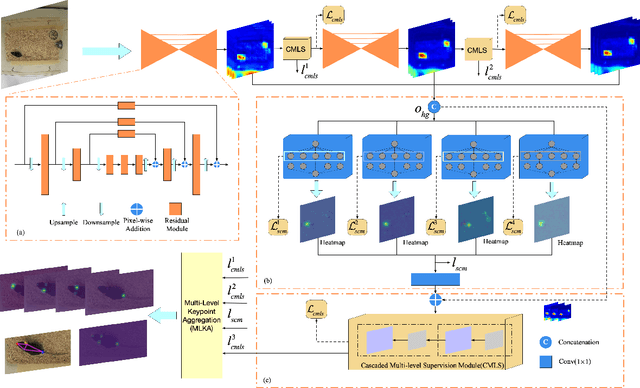

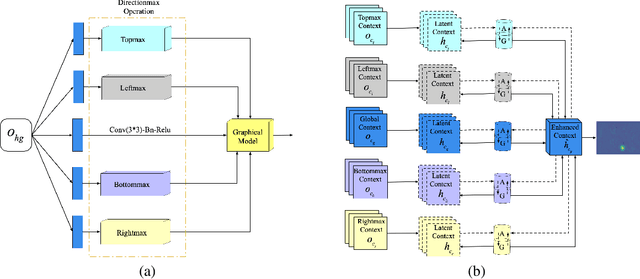
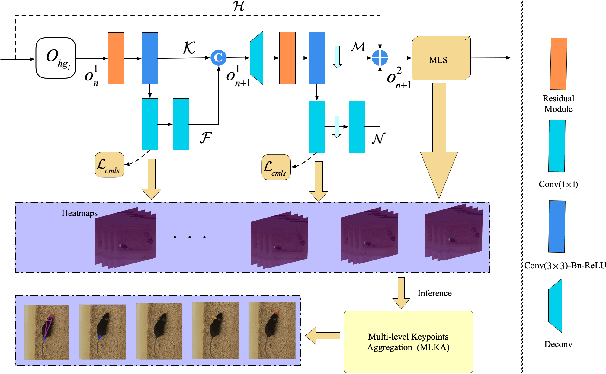
Abstract:Automated analysis of mouse behaviours is crucial for many applications in neuroscience. However, quantifying mouse behaviours from videos or images remains a challenging problem, where pose estimation plays an important role in describing mouse behaviours. Although deep learning based methods have made promising advances in mouse or other animal pose estimation, they cannot properly handle complicated scenarios (e.g., occlusions, invisible keypoints, and abnormal poses). Particularly, since mouse body is highly deformable, it is a big challenge to accurately locate different keypoints on the mouse body. In this paper, we propose a novel hourglass network based model, namely Graphical Model based Structured Context Enhancement Network (GM-SCENet) where two effective modules, i.e., Structured Context Mixer (SCM) and Cascaded Multi-Level Supervision module (CMLS) are designed. The SCM can adaptively learn and enhance the proposed structured context information of each mouse part by a novel graphical model with close consideration on the difference between body parts. Then, the CMLS module is designed to jointly train the proposed SCM and the hourglass network by generating multi-level information, which increases the robustness of the whole network. Based on the multi-level predictions from the SCM and the CMLS module, we also propose an inference method to enhance the localization results. Finally, we evaluate our proposed approach against several baselines...
Perceptual underwater image enhancement with deep learning and physical priors
Sep 26, 2020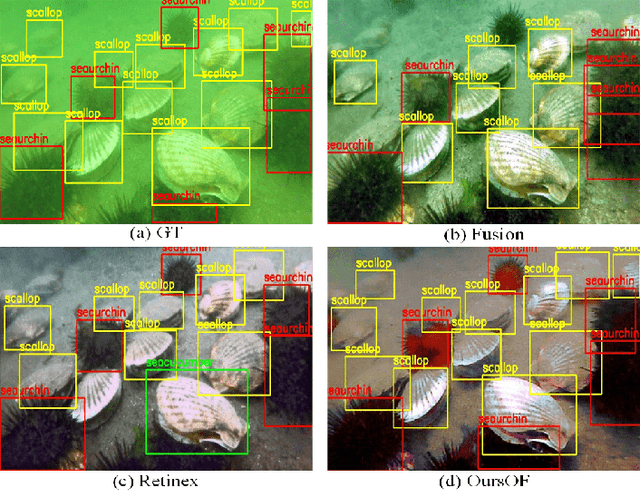

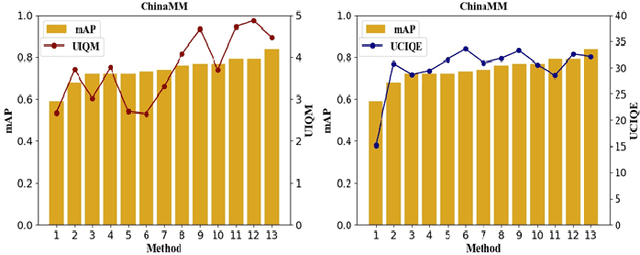

Abstract:Underwater image enhancement, as a pre-processing step to improve the accuracy of the following object detection task, has drawn considerable attention in the field of underwater navigation and ocean exploration. However, most of the existing underwater image enhancement strategies tend to consider enhancement and detection as two independent modules with no interaction, and the practice of separate optimization does not always help the underwater object detection task. In this paper, we propose two perceptual enhancement models, each of which uses a deep enhancement model with a detection perceptor. The detection perceptor provides coherent information in the form of gradients to the enhancement model, guiding the enhancement model to generate patch level visually pleasing images or detection favourable images. In addition, due to the lack of training data, a hybrid underwater image synthesis model, which fuses physical priors and data-driven cues, is proposed to synthesize training data and generalise our enhancement model for real-world underwater images. Experimental results show the superiority of our proposed method over several state-of-the-art methods on both real-world and synthetic underwater datasets.
 Add to Chrome
Add to Chrome Add to Firefox
Add to Firefox Add to Edge
Add to Edge